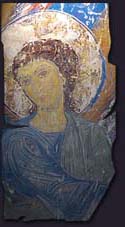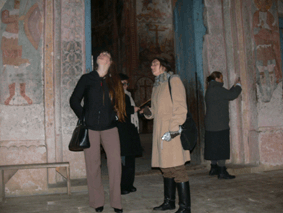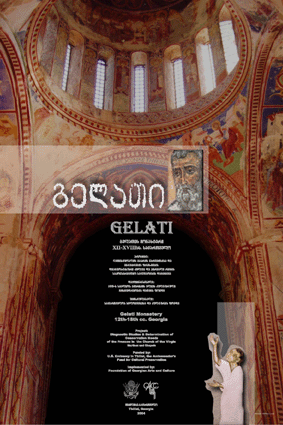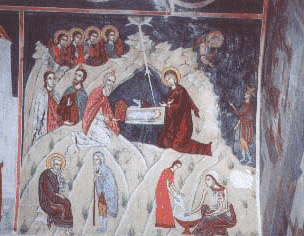
Creative Indust.& Crafts Develop.

PRESERVATION OF MEDIEVAL MONIMENTS
THE CHURCH OF THE VIRGIN AT GELATI
12th-18th cc. Kutaisi, Georgia; UNESCO World Heritage siteThe Gelati Monastery and Academy is one of the most important religious and cultural landmarks in Georgia. Founded by King David the Builder in 1106, the monastery served throughout the medieval period as an important religious and cultural-educational center of Georgia and burial place of Georgian kings. Consisting of several buildings from different periods, Gelati Monastery displays the diversity of types of both Georgian ecclesiastic architecture and secular design. The main Church of the Nativity of the Virgin (12th century) is a cross-domed construction with three apses projecting on the east. The narthex, the southern annex with the portal, and the east and west chapels were added later in the same century, whereas the northern annex with two chapels and two portals was built during the 13th century. The Academy (12th century) - a large structure with the rectangular planning survived in ruins has been recently restored and opened to the visitors. The porch richly decorated with stone curved ornaments was added the Academy in the 14th century.
Alongside the architectural variety, the church of the Virgin is rich in paintings executed in different periods and mediums – Mosaic and fresco. Dating back to 12th-19th centuries, these murals offer a unique glimpse of nearly the whole history as well as the important stages of the development of Georgian church painting. Amongst them are the famous mosaic of the apse – the Virgin with child Christ juxtaposed with the archangels and the unique 12th century frescos of the Narthex. The latter contains the images of the Seven Ecumenical Councils and the “Miracle of St. Euphemia”, which are exceptional for Georgia. The murals of the southeastern chapel are examples of Palaeologan style painting, the later stage of which is exemplified by the refined fragments of the painting of the southern portal (1360-1395). The other frescoes of the 15th, 16th and 17th century reflect the variety of styles of that period. The mural of the northeastern chapel (first half of the 17th c.), reveal the high degree of skill of the master (second half of the 17th c.), while the frescos of the northwestern chapel are less skilled. The murals of southwestern chapel of St Marine are executed in the peculiar “folk style”, developed in Georgia in Late Medieval period. This style, specifically national in character, is distinguished with its naïve pictorial language and extremely enchanting, expressive imagery.
Each layer of the painting, together with its iconographic and stylistic features, with its abundance of inscriptions and historic portraits, including the 16th century portrait of David IV in the central space.
The main church, provides valuable materials not only for the study of medieval Georgian art but for the culture of the entire Eastern Christian medieval world.2016-2017 - Stone Conservation of the Chappels of the Church of the
Virgin (12th-18th) in Gelaty Monastery
_________________________________________________________________
Funded by:
US Ambassadors Large Grants Programme,
National Agency for Cultural heritage Preservation of Georgia
Project Partners: leading- Georgian Arts and Culture Center; Georgian Heritage; Restoration Faculty at the Tbilisi State Academy of Arts; "1+1" ltd, "Gorso" Ltd, Ikorta 2007
Project Team: Project Director – Maka Dvalishvili, GACC; Administration: Ana Shanshiashvili, Tamuna Kiknadze (GACC); Supervision - Nana Kuprashvili (TSAA), Architectural Rehabilitation, Methodology and Supervision - Kakha Trapaindze (TSAA, Georgian Heritage), Restorers group : Cheif restorer - Sandro Rubashvili (“1+1”); Restorers : Salome Akhalashvili, Nikoloz Gelashvili, Alexander Todua, Elene Torgvaidze, Giorgi/ George Navrozashvili, Revaz Tatishvili, Tamuna Meliva, Giorgi Trapaidze; Architect Restorers: Gia Sosanidze (NACHPG) Tengiz Gabunia; Engineer constructors: Gigla Chanukvadze (NACHPG) David Ramishvili (TSAA); Engineering & constructions: Ghia Khurtsilava, Tariel Kervalishvili (“IkorTa”); Art historian Research: George Gagoshidze (NACHPG)
Project Purpose & Activities: The project aims provision of conservation measures of the stone of the chapells of the church. Conservation measures include: pointing and filling of cracks and joints, anchoring of loosened stones, reconstruction of missed parts by lime and pozzolona, re-assembling of defragmented stones, treatment with biocide
International Consultancy: Stone Conservation Methodology and Treatment – Stefano Volta, SUPSI, University of Applied Sciences of Southern Switzerland, Lugano.
2015-2017 - Stone Conservation of the Church of the
Virgin (12th-18th) in Gelaty Monastery
_________________________________________________________________Funded by:
Municipality Development Fund / WB
Project Partners: leading- Georgian Arts and Culture Center; Georgian Heritage; Restoration Faculty at the Tbilisi State Academy of Arts; "1+1" ltd, "Gorso" Ltd, Ikorta 2007
Project Team: Project Director – Maka Dvalishvili, GACC; Administration: Ana Shanshiashvili, Tamuna Kiknadze (GACC); Supervision - Nana Kuprashvili (TSAA), Architectural Rehabilitation, Methodology and Supervision - Kakha Trapaindze (TSAA, Georgian Heritage), Restorers group: Cheif restorer - Sandro Rubashvili (“1+1”); Restorers : Salome Akhalashvili, Nikoloz Gelashvili, Alexander Todua, Elene Torgvaidze, Giorgi/ George Navrozashvili, Revaz Tatishvili, Tamuna Meliva, Giorgi Trapaidze; Architect Restorers: Gia Sosanidze (NACHPG) Tengiz Gabunia; Engineer constructors: Gigla Chanukvadze (NACHPG) David Ramishvili (TSAA); Engineering & constructions: Ghia Khurtsilava, Tariel Kervalishvili (“IkorTa”); Art historian Research: George Gagoshidze (NACHPG)
International Consultancy: Stone Conservation Methodology and Treatment – Stefano Volta, SUPSI, University of Applied Sciences of Southern Switzerland, Lugano. Dr. Alkis Prepis, Dr. Georgio Crocci, Mr. David MichelmoreThe project aims provision of conservation measures of the stone of the drum and the cross-arms of the church and reinforcement of the dome-drum system.
Project Activities:
* Installation of the reinforcement ring on the lowest point of the drum
* Installation of monitoring system
* Stone Conservation measures include: pointing and filling of cracks and joints, anchoring of loosened stones, reconstruction of missed parts by lime and pozzolona, re-assembling of defragmented stones, treatment with biocide_________________________________________________________________
2013-2017 - Architectural Rehabilitation of the Church of the
Virgin (12th-18th) in Gelaty Monastery
_________________________________________________________________
Funded by:
US Ambassadors Large Grants Programme,
National Agency for Cultural heritage Preservation of GeorgiaProject Partners: leading- Georgian Arts and Culture Center; Georgian Heritage; Restoration Faculty at the Tbilisi State Academy of Arts; Ikorta 2007
Project Team: Project Director – Maka Dvalishvili, GACC; Administration: Ana Shanshiashvili, Tamuna Kiknadze, Ana Vashakidze (GACC); Architectural Rehabilitation, Methodology and Supervision - Kakha Trapaindze (TSAA, Georgian Heritage), Architect Restorers: Gia Sosanidze (NACHPG) Tengiz Gabunia; Engineer constructors: Gigla Chanukvadze (NACHPG) David Ramishvili (TSAA); Engineering & constructions: Ghia Khurtsilava, Tariel Kervalishvili (“IkorTa”); Art historian Research: George Gagoshidze (NACHPG); Ceramic Roofing : Maia Gabadadze, Genadi Ekizashvili private ceramic studios
Stone rehabilitation: Sandro Rubashvili (“Gorso”); Restorers : Salome Akhalashvili, Nikoloz Gelashvili, Alexander Todua, Elene Torgvaidze, Giorgi/ George Navrozashvili, Revaz Tatishvili, Tamuna Meliva, Giorgi Trapaidze
International Consultancy: Stephano Volta, Stone Conservation Methodology and Treatment – Stefano Volta, SUPSI, University of Applied Sciences of Southern Switzerland, Lugano. Dr. Alkis Prepis, Dr. Georgio Crocci, Mr. David MichelmoreThe project aims to provide full scale conservation of the architectural structure of the Main church of the Virgin. This in turn will prepare ground for the further preventive conservation of the wall paintings, include in mosaic and frescos preserved in the interior of the church.
In particular the project will target different conservation problems of the architectural structure, with the aim to eliminate causative effects such as water infiltration, vegetation growth, and wall inner cavities.
Project Activities:
Design of hand-made ceramic tiles for the roofing, based upon the study of tiles unearthed during the archeological excavation around the monastery, the method piloted and reintroduced on the buildings of the Academy, the belfry and the church on St. Nicholas.
Removal of the existing tin roofing on the dome, cross arms and chapels cleaning of the stone slabs beneath
Conservation of the cornices – The consolidation of the existing stones, replacement of the missing stones, cleaning of the weathered binding mortar, injection of existing cracks with the lime solution and reinstallation of the stones with the lime mortar.
Rehabilitation of the roofing - Arrangement of wooden construction, filling with lime mortar and covering of the whole perimeter with hand-made glazed ceramic tiles.
Glazing of the window openings
Documentation and Recording - The entire project will be documented with drawings and photos. They will include both general and detailed shots of the monument, and the working process of the each activity of the project.
Educational activities - Project in collaboration with the Faculty of Conservation of Tbilisi State Academy includes providing on-site opportunities for students of stone and fresco conservation to contribute to the exchange of the experience with the younger generation.____________________________________________________________________________
2014-2015 - “Diagnostic study and Conservation of the Mural Painting of the Dome of the Church of the Virgin at Gelati monastery”
_________________________________________________________________
Funded by: US Embassy in Georgia, the Ambassadors Fund for Cultural Preservation
Project team: Fresco Conservation: Project Director – Maka Dvalishvili, GACC
Administration: Ana Shanshiashvili, Tamuna Kiknadze, Ana Vashakidze, Maia Antadze, Malkhaz Gelashvili (GACC); Scientific leader: Nana Kuprashvili (TSAA); Restorers: Sando Rubasvili ( “Gorso”), Local Consultant: Lado Gurgenadze; Restorers: Salome Akhalashvili, Nikoloz Gelashvili, Alexander Todua, Elene Torgvaidze, Giorgi Navrozashvili, Revaz TatishviliThe project aims to preserve the frescos of the dome at the main Church of the Virgin in Gelati Monastery. In particular, it involves undertaking of laboratory research of current situation, and actual conservation works: consolidation of the plaster and pain layer, removal of salts etc. Alongside conservation activities, the project combines educational and promotional activities that give an additional social value to the particular initiative.
As a result of the conservation activities envisaged in the framework of the project, the 16th century frescos of will be preserved for future generations.
Project Activities
The particular project will be implemented in 2 stages:
1st phase will involve the laboratory analyses of the plaster and painting layer in particular : Analyses of the plaster, Salt identification, Analyses of painting layer, Biological analyses
2nd phase Elaboration of detailed methodology on the bases of conducted studies and implementation of conservation works which included: Cleaning the fresco surface, Consolidation of the paint layer, Consolidation of the detached plaster with a hydraulic lime, Injection of the cracks on plaster with lime solution; Extraction of soluble salts, Treatment to remove salts, Replacement of previous gypsum and cement fillings, Treatment of the biological agents with a wide spectrum biocideDocumentation and Recording. The entire project will be documented with drawings and photos. They will include both general and detailed shots of the monument, and the working process of the each activity of the project.
Educational activities. Project in collaboration with the Faculty of Conservation and Art History and Theory of Tbilisi State Academy includes providing on-site opportunities for students of fresco conservation to contribute to the exchange of the experience with the younger generation of the Conservation.
Promotional activities. The various activities covered by the project will be popularized through different TV channels and printed media.
______________________________________________________
2012 -2013 - Conservation of the Frescos of St Marine Chapel
and Southern Porch at the Church of the Virgin in Gelati Monastery
_________________________________________________________________Funded by:
U.S. Embassy in Tbilisi,
the Ambassadors Fund for Cultural PreservationProject team: Project Director – Maka Dvalishvili, GACC; Administration: Ana Shanshiashvili, Tamuna Kiknadze (GACC); Scientific leader: Nana Kuprashvili (TSAA); Wall Painting Conservator team leader– Alexander Rubashvili, Restorers- Salome Akhalashvili, Nikoloz Gelashvili, Alexander Todua, Elene Torgvaidze, Giorgi/ George Navrozashvili, Revaz Tatishvili; Local Consultant: Guram Cheishvili
The project aimed to preserve the frescos of St. Marine Chapel and Southern Porch of the main Church of the Virgin at Gelati Monastery. In particular, it involved undertaking of conservation works: emergency stabilization of the architectural structure, such as roof and window damages to prevent water infiltration in the interior and the actual conservation of frescos: consolidation of the plaster and pain layer, removal of salts etc. Alongside conservation activities, the project combined educational and promotional activities that gave an additional social value to the particular initiative.
As a result of the conservation activities envisaged in the framework of the project, the 15th -16th century frescos of St. Marine Chapel, executed in the peculiar “folk style” has been preserved. This in turn, will serve as a one more tangible evidence of US/AFCP support to Georgian Cultural Heritage.
Project Activities
Emergency Architectural stabilization included - Installation of the temporary roofing on the damaged roof, which prevented water infiltration in the interior until the entire roof would be changed in the framework of the full-scale architectural rehabilitation project; Cleaning and injecting of cracks with lime mortar; Glazing of window openings to keep interior microclimate: temperature and humidity stable; Removal of concrete fillings applied during the previous restorations, which in turn cause the salt efflorescence on the frescos in the interior;
Conservation of the frescos involved - Acquisition and transport of materials; Construction of scaffolding in the interior; Drying and cleaning up the fresco surface; Updating laboratory study results: analysis of salts, pigments and bio deterioration; Consolidation of the paint layer with a suitable adhesive; Consolidation of the detached plaster with a low-salt hydraulic lime; Injection of the cracks on plaster with lime solution; Extraction of soluble salts; Treatment to remove salts; Replacement of previous fillings in unsuitable material with lime/sand fillings; Biocide tests to select the appropriate material for bio deterioration treatment; Treatment of the biological agents with a wide spectrum biocide
Documentation and Recording - The entire project will be documented with drawings and photos. They will include both general and detailed shots of the monument, and the working process of the each activity of the project.
Educational activities - Project in collaboration with the Faculty of Conservation and Art History and Theory of Tbilisi State Academy includes providing on-site opportunities for students of fresco conservation to contribute to the exchange of the experience with the younger generation of the Conservation.
Promotional activities - The various activities covered by the project will be popularized through different TV channels and printed media.________________________________________________________
2003-2004 - Diagnostic study and determination of restoration
needs of the North & South Chapels of Gelati Monastery
________________________________________________________Funded by:
U.S. Embassy in Tbilisi,
the Ambassadors Fund for Cultural PreservationProject team: Project Director – Maka Dvalishvili, GACC; Administration: Ana Shanshiashvili, Tamuna Kiknadze (GACC); Laboratory Research - Nana Kuprashvili, Tbilisi State Academy of Arts, Faculty of Restoration; Fresco Restorer – Guram Cheishvili; Architect restorer - Tengo Gabunia; Geologist - Darejan Mgebrishvili; Humidity specialist - Nikolos Bantsatdze; Art Historian - Keti Mikeladze; International Consultants: Giulia Caneva, (University Roma 3), Ippolitto Massary, Marck Gittings, Sabina Vedovello (CBC) Roma, Italy; Analyses - "Artelab S.r.l." Bologna, Italy
The project aimed to carry out a study of the physical condition of the narthex, Southern and Northern chapels of the Church of the Virgin at Gelati, identification of the mural damages, its underlying causes, and determination of conservation needs. Moreover the project envisaged gathering of the full documentation, including archive materials, as well as graphic and photographic documents created during the implementation of the project. The iconographic schemes with indication of damages and etc. Based on the conducted studies the recommendations were elaborated for the future rehabilitation of the architecture and conservation of the frescos.
Project Activities
Archive documentation The project envisaged gathering of the archive documentation about the previous restorations.
Geological evaluation The geological research of the nearby territory of the church showed that the Monastery complex is built on a slope, which is made up of the Cretaceous limestone and marl.
Study of the humidity condition The temperature and the relative humidity were measured in the interior and exterior of the church. The measurements showed high relative humidity in the Northern annex and the Southwestern Chapel of the church. The main source of dampness is the air.
Study of the architectural structure From the visual inspection of the structure showed that The precipitation comes down, damaging the walls from outside and penetrates into the interior. The lime mortar is washed out from the joints of the facing The cement mortar used during the restorations negatively affects the building.
Study of the condition of the painting:
The techniques – The painting are executed in mixed technique, in secco and fresco.
Damage of the painting - The damage to the painting is mainly flecking, powdering, cracking and detaching from walls on the part of the plaster; deformation of pigments, and salt crystallization. Biological damage is “pink coloration”, fungus, mould and moss. The gypsum borders used as the strengthening medium during the previous restorations have a negative effect on the murals.
Laboratory study of paintings – chemical and biological analyses.
Documentation and photo fixation of the painting In the course of the project was created graphic documentation indicating the existing damages of the building; the graphic schemes of the murals of the Southwestern chapel and South Porch. Photos with direct and raking light show all kind of plaster and paint layer damages and the ultraviolet light reveal retouching and invisible details. The whole process of the project duration is depicted on the photos.







